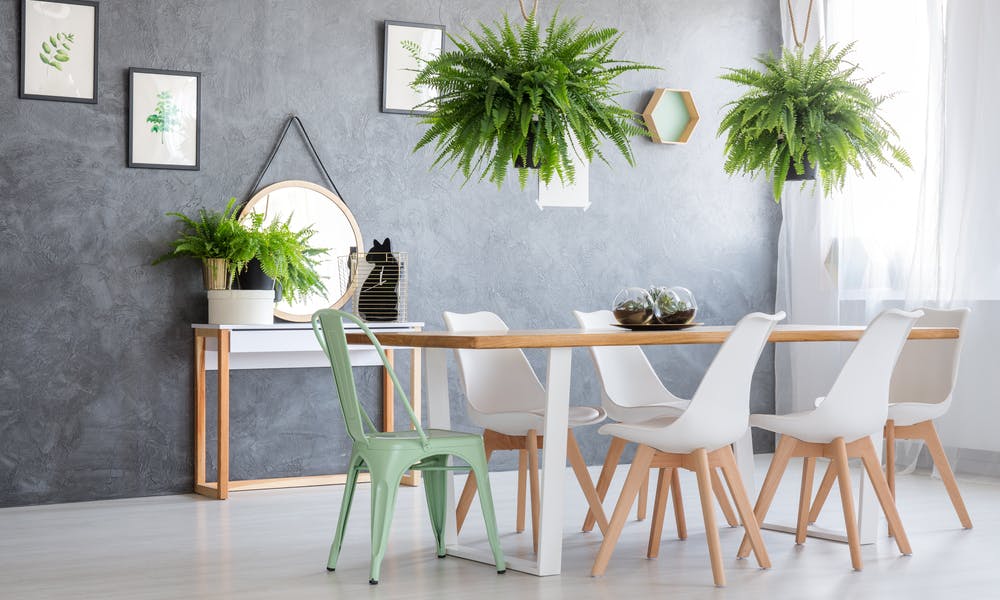MENU
Hanging Indoor Plants – Ideas, Tips and More

If you would like to be closer to nature and be surrounded by plants, you can consider plants such as cacti, decorative plants through foliage, and hanging plants. They can bring the much-needed freshness and decorate any corner of your house.
Hanging plants are easy to place because they do not take up much space. They create amazing effects anywhere you place them. Whether they are located on the edge of a window, staircase, or on a shelf. Hanging plants can change the atmosphere of your house and bring nature indoors. Let’s enjoy together knowing something new about these plants:
* What are hanging indoor plants
* Some of the best-known hanging indoor plants
What are Hanging Indoor Plants
Hanging plants can beautifully decorate your gardens, terraces, and any room in your home. These plants can bring color and beauty anywhere you place them, whether it is a library or a simple wall. Hanging plants can be ideal for naturally delimiting the spaces in your home. These plants are easy to care for, and they have minimal requirements for temperature or light. They can also work as an air filter for your house!
You can use ivy to delimit two areas of a room, and the ivy is the most suitable plant for such use, due to the appearance and the variety of these plants. You just need some support to help the plant grow. Ivy is noted for its extremely rapid growth, but also its easy to care for. It is recommended to place these plants in illuminated rooms, and watering should be done every three or four days. To facilitate your work, it is recommended to use self-watering pots. It is the best solution for employed people that don’t have much free time. By using such pots, the water is held in the tank for up to four weeks!
Philodendron is a hanging plant, which can grow all year long if you provide it with optimal conditions. This plant needs a moderate amount of water, light, full heat, and the temperature between 72 and 77° F for a beautiful development. If you have libraries or shelves that need to be decorated, then you can use the philodendron.
Ceropegia Sandersonii is an amazing umbrella plant with beautiful flowers that reach up to 6 feet. This hanging plant does not need too much water, but it needs full light and it must be protected from the direct action of the sun.
All leafy decorative plants need a foliage fertilizer for green plants and palm trees. This spray offers quick absorbable nutrients for your plants and a beautiful and healthy gloss to the leaves. The plants become visibly more beautiful, healthier, and stronger.
Some of The Best-Known Hanging Indoor Plants
In the followings section, we present some of the most beautiful and best-known indoor hanging plants.
Hoya Carnosa or Wax Flower is a small hanging shrub, native to Asia. It has fleshy leaves, with small, pink flowers, looking like wax or porcelain. Hoya flowers are placed in bunches, and have stamens in strong shades of red and purple. The wax flower needs a few years of growth until the first buds appear, but after this period of development, it blooms every year. The plant needs a lot of light and water to stimulate the flowering process. If you want the flower to grow properly, it is advisable to tie it with hooks.
The devil’s ivy impresses with an interesting aspect; it has the stained leaves in different shades of green and yellow. It is a hanging plant that adapts quickly to the conditions in the apartment. The devil’s ivy is a perennial plant, originating from the Solomon Islands, that can reach up to 39 feet in the natural environment. In the pot, the plant reaches up to about 6.5 feet. The flower is spike-shaped, and this plant does not bloom in the apartment, only in a natural environment.
The Malabar lily is a hanging plant, native from tropical Africa. It has bright green leaves and has vibrantly colored flowers. The plant blooms from July to October, and in the apartment, it reaches a size of 6.5 feet. The Malabar lily is a spectacular plant due to its large flowers that reach 4 inches in diameter. The Malabar lily likes to climb, so you need to hang the plant on tall stands to let it grow properly. It needs a lot of air and moisture, so it is better to spray the leaves more frequently.
Passiflora is a hanging plant with an exotic, extremely interesting appearance. It develops very well under the conditions of the apartment and needs a place away from the current and direct sunlight. This plant is originally from South America. Passiflora develops rapidly from spring to autumn and reaches a height of 20 feet. Passiflora blooms from early summer to late autumn, and flowers have a delicate scent.
The unusual tillandsia grows like a string. Before it blooms, the leaves of tillandsia are bright red in color. To be able to bloom efficiently, the plant needs direct sunlight. Tillandsia needs a little care, so you should spray the plant weekly, and you should not place these plants in direct sunlight. If you hang Tillandsia up, for example by a hook, you may always have a garland in the room.
This hanging plant grows rapidly, reaching impressive sizes between 6 and 13 feet long. The name of this plant comes from the shape of a heart of its leaves, which can be red-colored, greenish-red or with white stripes. Ceropegia needs humidity and heat to develop to its normal capacities. The multiplication process is quite easy, happening through the stockings that increase during the spring.
No matter which hanging plant you choose to place in your home, they are sure to make a statement. Hanging plants are considered one of the most natural decorations one can have in their home.

